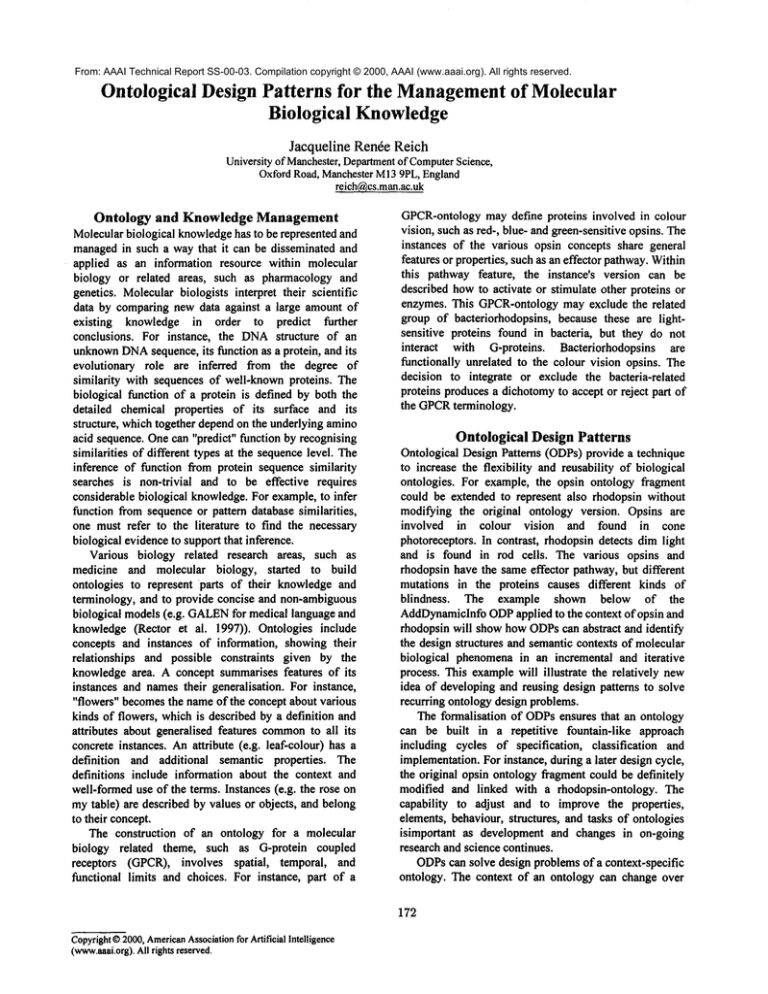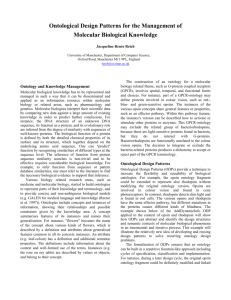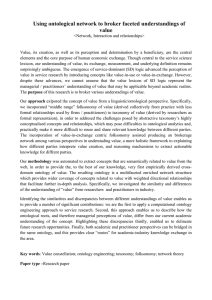
From: AAAI Technical Report SS-00-03. Compilation copyright © 2000, AAAI (www.aaai.org). All rights reserved.
Ontological Design Patterns for the Managementof Molecular
Biological Knowledge
Jacqueline Ren6e Reich
Universityof Manchester,Department
of Computer
Science,
OxfordRoad,ManchesterM13 9PL, England
reich(~ss.man.ac.uk
Ontology and Knowledge Management
Molecularbiological knowledgehas to be represented and
managedin such a way that it can be disseminated and
applied as an information resource within molecular
biology or related areas, such as pharmacology and
genetics. Molecularbiologists interpret their scientific
data by comparing new data against a large amount of
existing knowledge in order to predict further
conclusions. For instance, the DNAstructure of an
unknown
DNA
sequence, its function as a protein, and its
evolutionary role are inferred from the degree of
similarity with sequences of well-knownproteins. The
biological function of a protein is defined by both the
detailed chemical properties of its surface and its
structure, which together dependon the underlying amino
acid sequence. Onecan "predict" function by recognising
similarities of different types at the sequencelevel. The
inference of function from protein sequence similarity
searches is non-trivial and to be effective requires
considerable biological knowledge.For example,to infer
function from sequence or pattern database similarities,
one must refer to the literature to find the necessary
biological evidenceto supportthat inference.
Various biology related research areas, such as
medicine and molecular biology, started to build
ontoiogies to represent parts of their knowledgeand
terminology, and to provide concise and non-ambiguous
biological models (e.g. GALEN
for medical language and
knowledge (Rector et al. 1997)). Ontoiogies include
concepts and instances of information, showing their
relationships and possible constraints given by the
knowledgearea. A concept summarises features of its
instances and namestheir generalisation. For instance,
"flowers" becomesthe nameof the concept about various
kinds of flowers, whichis described by a definition and
attributes about generalised features common
to all its
concrete instances. Anattribute (e.g. leaf-colour) has
definition and additional semantic properties. The
definitions include information about the context and
well-formeduse of the terms. Instances (e.g. the rose on
mytable) are described by values or objects, and belong
to their concept.
The construction of an ontology for a molecular
biology related theme, such as G-protein coupled
receptors (GPCR), involves spatial, temporal, and
functional limits and choices. For instance, part of a
GPCR-ontologymay define proteins involved in colour
vision, such as red-, blue- and green-sensitive opsins. The
instances of the various opsin concepts share general
features or properties, such as an effector pathway.Within
this pathway feature, the instance’s version can be
described howto activate or stimulate other proteins or
enzymes. This GPCR-ontologymay exclude the related
group of bacteriorhodopsins, because these are lightsensitive proteins found in bacteria, but they do not
interact with G-proteins. Bacteriorhodopsins are
functionally unrelated to the eolour vision opsins. The
decision to integrate or exclude the bacteria-related
proteins producesa dichotomyto accept or reject part of
the GPCRterminology.
Ontological Design Patterns
Ontological Design Patterns (ODPs)provide a technique
to increase the flexibility and reusability of biological
ontologies. For example, the opsin ontology fragment
could be extended to represent also rhodopsin without
modifying the original ontology version. Opsins are
involved in colour vision and found in cone
photoreceptors. In contrast, rhodopsin detects dim light
and is found in rod cells. The various opsins and
rhodopsin have the sameeffector pathway, but different
mutations in the proteins causes different kinds of
blindness.
The example shown below of the
AddDynamiclnfo
ODPapplied to the context ofopsin and
rhodopsin will showhowODPscan abstract and identify
the design structures and semantic contexts of molecular
biological phenomenain an incremental and iterative
process. This examplewill illustrate the relatively new
idea of developing and reusing design patterns to solve
recurring ontology design problems.
The formalisation of ODPsensures that an ontology
can be built in a repetitive fountain-like approach
including cycles of specification, classification and
implementation.For instance, during a later design cycle,
the original opsin ontology fragment could be definitely
modified and linked with a rhodopsin-ontology. The
capability to adjust and to improve the properties,
elements, behaviour, structures, and tasks of ontologies
isimportant as development and changes in on-going
research and science continues.
ODPscan solve design problemsof a context-specific
ontology. The context of an ontology can change over
172
Copyright
©2000,American
Association
for ArtificialIntelligence
(www.aaai.org).
Allrightsreserved.
time, such as first excludingthe bacteria related protein
and focusing on humanproteins but later integrating
bacteriorhodopsin. Theoretically, the contexts can be
related to processes and techniques for the creation,
collection, indexing, organisation, distribution, access to
and evaluation of scientific knowledge.For instance, the
context of knowledgeevaluation maymovefrom a first
goal to analyse scientific texts concentrating on opsin
related literature to the goal to expandthe analysis to
rhodopsin related articles. To provide the necessary
flexibility
to broaden the range of analyses, the
decomposition, organisation and classification of a
scientific vocabularyhave to consider the encapsulation,
granularity,
and dependency of concepts, and the
performance, evolution, and reusability of the complete
ontology. Temporalobjectives, like our opsin-rhodopsin
example, influence 1) how tightly sub-ontologies or
individual concepts are designed and at whichdegree of
granularity, 2) whichconcept-interfaces and inheritancehierarchies are defined, and 3) which key-relationships
are established amongthem.
So far, ten different ODPsare defined (Table 1)
(Reich 1999a,b, in press), which can be implemented
various knowledge specification
or programming
languages.
TerminoiogicalHierarchy to composeconceptsand instances
ODP
into part-wholehierarchies
UpdateDependencies
to notify interdependentconcepts
ODP
and instances if one concept is
chan~ed
DefinitionEncapsulation to definea familyof definitions,
ODP
andto encapsulateeachone
same construction process for
ExpressionComposer
ODP
different concepts
ChainOfExpressions
multiple concepts can fulfil a
ODP
context
InteractionHiderODP
conceptencapsulatesinteractionof
conceptsor instances
TerminologyOrganizer interface creates and organises
ODP
conceptsor instances, realised by
sub-concepts
Mask ODP
to represent completesub-concepts
as instances
UnspecificTermODP
to manage
unspecific instances at
fine sranularities
AddDynamiclnfo
ODP
to add information and meaning
dynamically
Table 1. Ontological Design Patterns (ODPs)
AddDynamicInfo ODP
G-protein-coupled receptors (GPCR)are the largest
family of cell-surface receptors. GPCRs
can also be called
G-protein-linked receptors. The GPCRfamily members
have similar structures and are evolutionarily related. Our
simple exampleinvolves opsins, the proteins for colour
vision, and rhodopsin,the proteins for vision in dimlight.
The AddDynamiclnfo ODP dynamically
adds
informationto instances, whichcan be withdrawnlater. It
provides a flexible alternative to sub-concepts for
extending the functionality
of an ontology. The
AddDynamiclnfoODPcan be used when an extension by
sub-concepts is impractical. Sometimesa large numberof
independent extensions are possible and they would
produce an explosion of sub-concepts to support every
combination. In our example, the original ontology
involves the representation of the information about
opsins showing concepts, such as colour vision, cone
cells, and disease-by-deficiency. To adapt the existing
ontology to the information of rhodopsin, information
about a different vision or cell type will be dynamically
added. Generally, the integration of rhodopsin can be
done in two different ways: 1) without using the
AddDynamicODPcreating a new concept for each
additional information, such as for dim light vision, and
rod cells; or 2) using the AddDynamicODPwithout
modifyingthe core ontology based on the information of
opsins.
The first approach requires more generalised and
abstract concepts. The concepts of colour vision and dim
light vision would be grouped into a higher concept
named, for instance, "vision", and the concepts of rod
cells and cone cells wouldbe grouped into the concept
"cell". The AddDynamiclnfoODPavoids those concepts
high up in the ontological hierarchy. This ODPencloses
the information to be addedin another instance, whichis
called an Infogdder.
Any InfoAddercan alter or
extend
theoriginal
instance’s
functionality
fromthe
outside.
Theinstance
itself
doesnotknowanything
about
itsInfogdders.
Instead
of trying
to support
detailed
features
inanabstract
constellation
ofconcepts,
a more
generalconceptaboutGPCRscan be definedand
information
will be addedincrementally
by the
NamelnfoAdder,the VisionInfoAdder,or the
CellInfoAdder. The NameInfoAdder will
distinguish the expressions "G-protein-coupledreceptors"
and "G-protein-linked receptors", the VisionInfoAdderthe colour vision and the dim light vision, and the
Cell Infogdder the context of cone or rod cells.
The following code shows how to implement
NameInfoAdder,
Cel 1 InfoAdder
and
VisionInfoAdder.
We willassumethatthereis a
concept called Property-E1,
which is an abstract
concept for various properties and provides abstract
operations, such as Add,Removeand Change.
173
Copyright
©2000,American
Association
for ArtificialIntelligence
(www.eaai.org).
Allrightsreserved.
class Property-El{
public :
Element( )
virtual void Add();
virtual void Remove ()
virtual void Change()
);
A sub-concept of Property-E1 is called an
InfoAdder, which has more specific functions than
Property-E1. InfoAdder will have sub-concepts,
such as NameInfoAdder,
CellInfoAdder
and
VisionInfoAdder,
whichwillbe specific
forvarious
information changes. Theycan add operations for specific
functionality.
The important
aspect of the
AddDynamiclnfo ODPis that it lets InfoAdders
appear anywhere a Property-E1 can.
class InfoAdder : public Property-El{
public :
InfoAdder (Element*)
virtual void Add()
virtual void Remove ()
virtual void Change()
private :
Property-El* el;
l;
InfoAdder
addsinformation
to the Property-E1
referenced by el.For each operation in the PropertyEl’sinterface,
suchas Add,InfoAdder
definesa
default implementationthat passes the context on to el.
void InfoAdder::Add()
el ->Add( )
}
Sub-concepts
of InfoAdder
definespecific,
added
information.
Forinstance,
theNameInfoAdder
addsa
nameelement
overriding
theAddoperation.
class NameInfoAdder: public InfoAdder {
public :
NameInfoAdder (Element*, name-el);
virtual void Add ()
private :
void addName (char*)
private :
char* name-el; //Added name element
};
void NameInfoAdder::Add()
InfoAdder::Add();
addName(name-el);
}
Experimental Results and Conclusions
Applying the AddDynamiclnfo,two issues were found
worthy of consideration: 1) An InfoAdder’ s interface,
such as NameInfoAdder,
has to conform to the
interface of the original instance(e.g. the original version
of the protein name, kind of vision or cell type), which
will be a sub-concept of Property-E1. 2) To ensure
conforming interface,
original
instances and
InfoAdders should descend from a commonconcept,
such as Property-E1. This commonconcept should
focus on defining an interface, not on storing data. The
definition of the data representation should be deferred to
sub-concepts, such as NameInfoAdder. Otherwise the
concept of the original instance might become too
complex,and the and sub-concepts will pay for features
they do not need.
Tightly connected concepts are hard to reuse in
isolation, since they dependon each other. This leads to
monolithic ontologies where a concept can not be
changed or removedwithout understanding and changing
many other concepts.
The application
of the
AddDynamiclnfoODPenables loose connections, which
increase the probability that a concept can be reused by
itself. This presupposes that an InfoAdder’
s interface
conformsto the interface of the original instance, and that
an InfoAdder changes the information of an instance
fromthe outside coveringit with an additional layer.
With AddDynamicInfo,ODPsimple concepts can be
defined and information added incrementally with
InfoAdders. Information can be composed from
simple pieces. It is easy to define new kinds of
InfoAdders independently from the concepts of the
instances they will extend even for unforeseenextensions.
All ODPswith code examplesare available from the
author. Contact: reieh~cs.man.ac.uk.
Acknowledgements
This work was done at the Department of Computer
Science of the University of Manchester. Manythanks to
Daniel Buchholzfor reviewing the manuscript.
References
Rector, A.L.; Bechhofer,S.; Goble,C. A.; Horrocks,I. R.;
and Solomon W. D. 1997. The GALENmodelling
languagefor medical terminology. Artificial Intelligence
in Medicine,9:139-171.
Reich, J. R. 1999. Ontological DesignPatterns for the
Integration of Molecular Biological Information.
Proceedingsof the GermanConferenceon Bioinformatics
(GCB’99),
156-165,
Hannover,
Germany,
http://www.bioinfo.de/isb/geb99/talks/reich
Reich, J. R. in press. ModellingMolecularBiological
Information: Ontologiesand Ontological Design Patterns:
Proceedingsof the 1 l th Conferenceof the Information
Resources Management Association (IRMA2000),
Anchorage, Alaska
174
Copyright© 2000, AmericanAssociationfor Artificial Intelligence
(www.aaai.org).All rights reserved.





